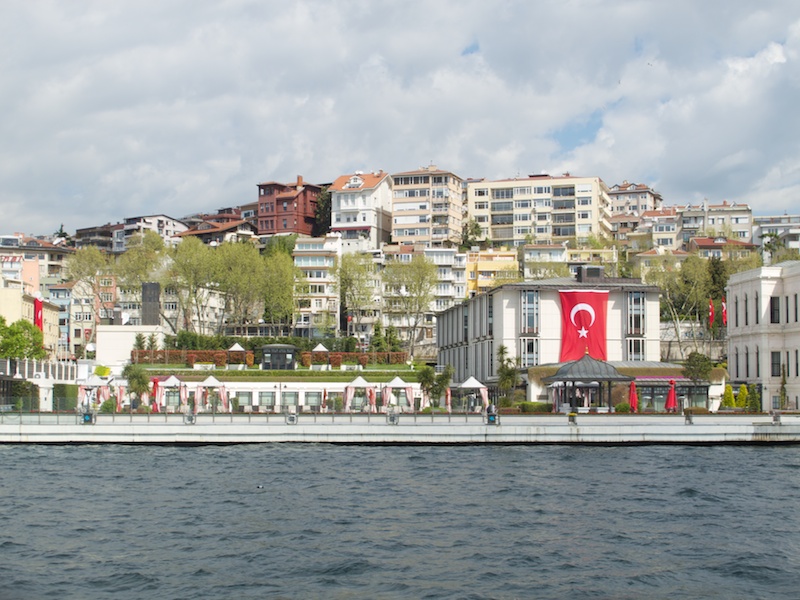 We love Italy. Anyone who knows us or has read this blog knows that. But a couple of days ago we bade goodbye to la repubblica italiana, boarded our LCC jet and winged our way from Europe to Asia, alighting at Istanbul, Turkey’s other airport, Sahiba Gokcen to begin a three day visit. Istanbul, Constantinople. You say tomato, I say tomahto. No matter how you slice this turkey, it is delicious.
We love Italy. Anyone who knows us or has read this blog knows that. But a couple of days ago we bade goodbye to la repubblica italiana, boarded our LCC jet and winged our way from Europe to Asia, alighting at Istanbul, Turkey’s other airport, Sahiba Gokcen to begin a three day visit. Istanbul, Constantinople. You say tomato, I say tomahto. No matter how you slice this turkey, it is delicious.
We stepped off the plane on the Asia side of Istanbul, marking our first visit to the continent. Gokcen airport is one of two airports that service Istanbul, playing LaGuardia to Ataturk airport’s JFK. It’s the dark meat to main airport’s white meat. This was only an issue in that our cruise line, which had promised us a transfer from the airport to our downtown hotel, refused to provide a transfer from Gokcen, claiming it was two and half hours from the city. Our travel agent offered to book a transfer for us on our own Turkish lira, offering us the low, low rate of $450 for our party of 6. We demurred, handling the arrangements on our own and €50 and 30 minutes later we arrived at the Ciragan Palace Hotel, our home base for the next three days as we explored Istanbul for the first time.
We love Italy. But after three days in Istanbul, a good start but clearly too short a visit, we can say we love Istanbul too. I don’t think Italy would mind, for many of the things that have fascinated us about Italy – the rich history, its art and architecture, its passion for living – we found in Istanbul as well. Our visit to Istanbul was a case of, if you can’t be with the one you love, love the one you’re with. That doesn’t count as cheating, does it?
 When we began our first day of touring with our private guide, a brilliant and affable young archeologist named Dalim, we made a very up front disclaimer to him. We let him know that we knew next to nothing about Turkey, about Istanbul, about the history, the art, the religion, the culture. We were not just a blank slate, we lacked the easel, the slate and anything to write with. Over the next three days Dalim, like Leonardo or Michelangelo drew for us a masterpiece of a picture of Istanbul and of his native Turkey. It is a beautiful tapestry -rich, vibrant, alive – and one that calls out to be reexamined over and over again. Just as Turkey strides Europe and Asia, just as Istanbul is served by Gocken and Attaturk, just as it goes by the names Istanbul, Constantinople and Byzantium, Istanbul is a complex, multifaceted place, deserving multiple looks from multiple angles. It is a diamond with thousands of facets, reflecting light and dazzling with its brilliance.
When we began our first day of touring with our private guide, a brilliant and affable young archeologist named Dalim, we made a very up front disclaimer to him. We let him know that we knew next to nothing about Turkey, about Istanbul, about the history, the art, the religion, the culture. We were not just a blank slate, we lacked the easel, the slate and anything to write with. Over the next three days Dalim, like Leonardo or Michelangelo drew for us a masterpiece of a picture of Istanbul and of his native Turkey. It is a beautiful tapestry -rich, vibrant, alive – and one that calls out to be reexamined over and over again. Just as Turkey strides Europe and Asia, just as Istanbul is served by Gocken and Attaturk, just as it goes by the names Istanbul, Constantinople and Byzantium, Istanbul is a complex, multifaceted place, deserving multiple looks from multiple angles. It is a diamond with thousands of facets, reflecting light and dazzling with its brilliance.
Ask me something about this pope or that, about an Italian gothic painter or a renaissance architect and I will probably know something or at least be confident enough to completely make up something. Ask me about an Ottoman sultan, a Muslim mosque or a patriarch of the orthodox church and you’ll get a blank stare. My ignorance was (and is) so great that before this visit, I thought the Ottoman Empire was a furniture store.
Well, after three days and some herculean efforts by Dalim I may be no expert about Istanbul or Turkey, but I have developed a deep respect, fascination and interest in it. I can’t believe it has been hiding out in plain sight all this time.
* * *
So at the risk of embarrassing myself, here are some of my impressions of Istanbul.
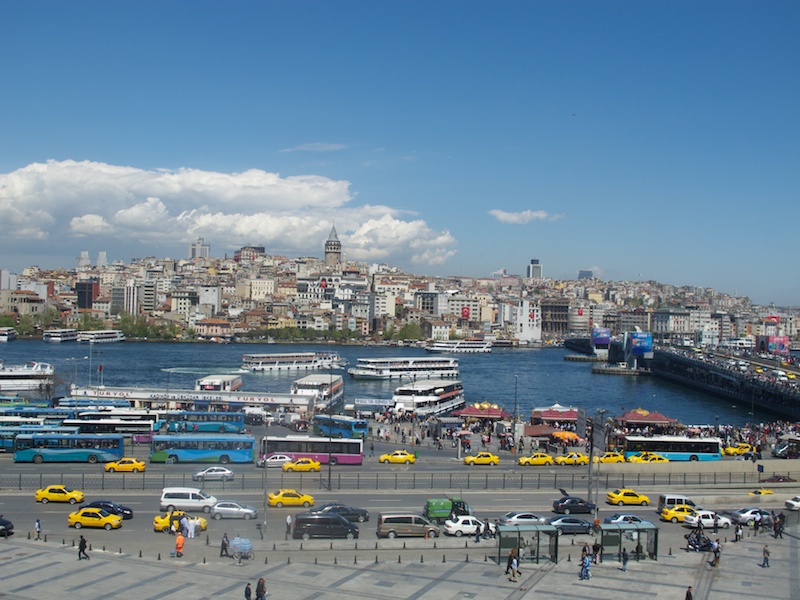 1. Istanbul is a huge, beautiful city. Straddling the Bosporus straits that separate Europe and Asia and separated by the Golden Horn, you are never too far from water or water views. Built on hills that rise out of those bodies of water, the city has some incredible views and looks a lot like Italian hilltowns that spill downhill.
1. Istanbul is a huge, beautiful city. Straddling the Bosporus straits that separate Europe and Asia and separated by the Golden Horn, you are never too far from water or water views. Built on hills that rise out of those bodies of water, the city has some incredible views and looks a lot like Italian hilltowns that spill downhill.
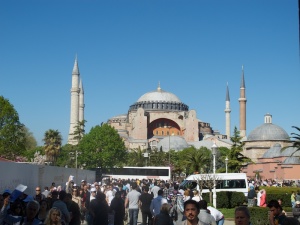 2. Mosques, with their minarets and domes make for an incredible skyline. I don’t recall how many mosques Dalim told us there were in Istanbul, but if you took one of the many cats that laze around in the sun and spun it in a circle by its tail, you would likely hit a few. I don’t think mosque cat battering would be looked on too kindly here, though.
2. Mosques, with their minarets and domes make for an incredible skyline. I don’t recall how many mosques Dalim told us there were in Istanbul, but if you took one of the many cats that laze around in the sun and spun it in a circle by its tail, you would likely hit a few. I don’t think mosque cat battering would be looked on too kindly here, though.
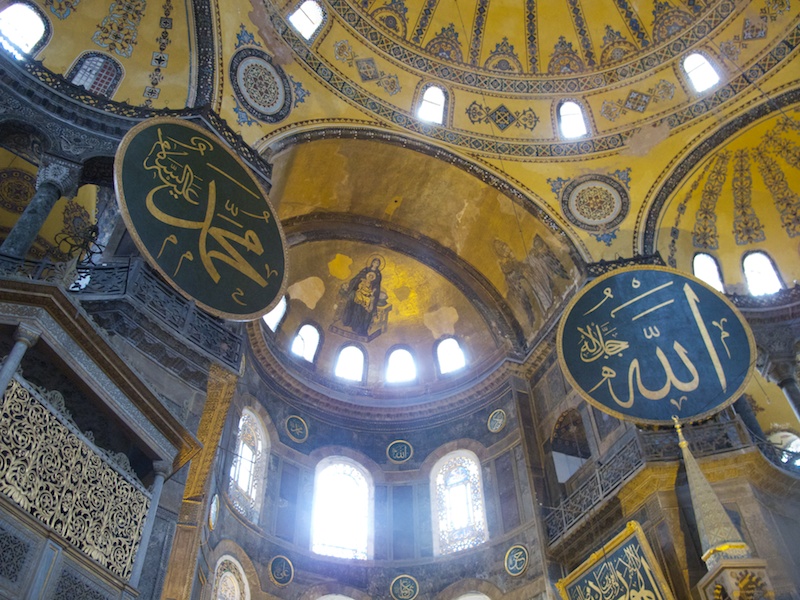 3. Mosques are incredible places. The ones we visited were mostly 16th and 17th examples and, just as modern Christian churches are for the most part modeled on older ones (except for a few avant garde, modernist atrocities), most modern mosques are patterned on these examples. The ones we visited were laid out along roughly the same lines – a central dome supported over a square center, with four naves of equal size – essentially a Greek cross with naves that radiate out from the center, with additional semi-domes, arches and buttresses to support the central dome. Inside, the central hall is huge, with an area where the public can visit and another area set off for prayers. The size and proportions give the building a palpable sense of calm and serenity. It seems like a space where you can easily commune with God.
3. Mosques are incredible places. The ones we visited were mostly 16th and 17th examples and, just as modern Christian churches are for the most part modeled on older ones (except for a few avant garde, modernist atrocities), most modern mosques are patterned on these examples. The ones we visited were laid out along roughly the same lines – a central dome supported over a square center, with four naves of equal size – essentially a Greek cross with naves that radiate out from the center, with additional semi-domes, arches and buttresses to support the central dome. Inside, the central hall is huge, with an area where the public can visit and another area set off for prayers. The size and proportions give the building a palpable sense of calm and serenity. It seems like a space where you can easily commune with God.
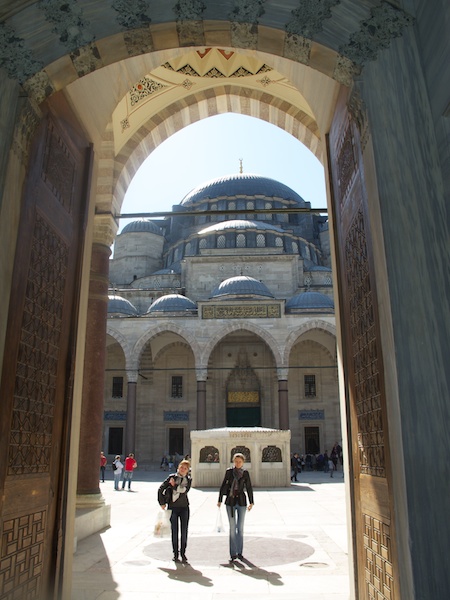 Of particular beauty was the Suleymaniye mosque, built in the mid 1500s. Built by the architect Sinan who, I take it, was considered the Bramante or Brunelleschi of Ottoman architecture, it is hard to imagine what he could have done to improve on this building. Perhaps our impression of it was improved by the smaller crowds, this mosque not as popular or as well known as the Blue Mosque or the Hagia Sofia. Every detail of this mosque complex (which included a library, a madrassa, a soup kitchen), inside and out, was clean, crisp, calming and no doubt inspires faith and reflection in its followers. Even for those of us mostly ignorant in the ways of Islam, it was hard not to be inspired to faith.
Of particular beauty was the Suleymaniye mosque, built in the mid 1500s. Built by the architect Sinan who, I take it, was considered the Bramante or Brunelleschi of Ottoman architecture, it is hard to imagine what he could have done to improve on this building. Perhaps our impression of it was improved by the smaller crowds, this mosque not as popular or as well known as the Blue Mosque or the Hagia Sofia. Every detail of this mosque complex (which included a library, a madrassa, a soup kitchen), inside and out, was clean, crisp, calming and no doubt inspires faith and reflection in its followers. Even for those of us mostly ignorant in the ways of Islam, it was hard not to be inspired to faith.
4. Turkey seems to be a place of great tolerance, religiously and culturally. No doubt Turkey is a majority Islam country, but it is intentionally secular in its politics and this intention seems to have worked, at least in the more liberal Istanbul. We saw people, mostly women, in traditional headwear and burkas, walking shoulder to shoulder with others in tshirts emblazoned with the worst of Americana. Homosexuality, at least we were told, is accepted in the cities and Christian and Jewish churches and temples are open for worship.
 This tolerance perhaps arises from the tradition of tolerance and multiculturalism that seems to have been the norm in the 16th and 17th centuries. We were particularly struck by the Hagia Sofia, originally a Christian church built (or rather rebuilt) by the Roman Emperor Justinian in the 6th century and later converted to a mosque. Here mosaics of Jesus and Mary stand side by side with signs announcing the greatness of Allah and Mohammed. Hard to imagine our churches being so open minded.
This tolerance perhaps arises from the tradition of tolerance and multiculturalism that seems to have been the norm in the 16th and 17th centuries. We were particularly struck by the Hagia Sofia, originally a Christian church built (or rather rebuilt) by the Roman Emperor Justinian in the 6th century and later converted to a mosque. Here mosaics of Jesus and Mary stand side by side with signs announcing the greatness of Allah and Mohammed. Hard to imagine our churches being so open minded.
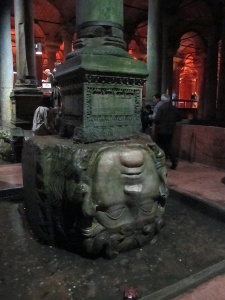 5. The old walled city of Istanbul, originally Constantinople and before that Byzantium, is a gem. Within its expansive walls there is such a concentration of Islamic, Christian, Byzantine and Roman treasures that it would make your head spin. In two and a half days we spent most of our time within the old city (with the notable exception of an unforgettable trip up the Bosporus on a private launch), spending time in the Hagia Sofia (a mosque converted from the largest church in eastern Christendom), the Blue Mosque, an immense underground cistern built by the Romans, the church of Chora, a tiny Romanesque church decorated in the 14th and 15th centuries that changed the way I looked at art and architecture and a number of Ottoman palaces. And we were able to fit all of that in between our main preoccupation – eating and drinking a la Turk.
5. The old walled city of Istanbul, originally Constantinople and before that Byzantium, is a gem. Within its expansive walls there is such a concentration of Islamic, Christian, Byzantine and Roman treasures that it would make your head spin. In two and a half days we spent most of our time within the old city (with the notable exception of an unforgettable trip up the Bosporus on a private launch), spending time in the Hagia Sofia (a mosque converted from the largest church in eastern Christendom), the Blue Mosque, an immense underground cistern built by the Romans, the church of Chora, a tiny Romanesque church decorated in the 14th and 15th centuries that changed the way I looked at art and architecture and a number of Ottoman palaces. And we were able to fit all of that in between our main preoccupation – eating and drinking a la Turk.
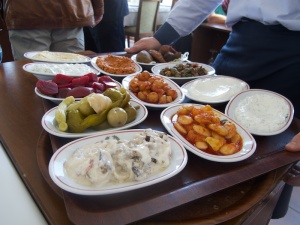 6. The food in Istanbul was a delight, a Turkish delight. And we did have plenty of that as well. Turkey is a breadbasket – it is the largest or nearly the largest producer in Europe of many fruits – quinces, cherries, oranges to name a few, nuts of all types and is abundant in its supply of meats. Every meal was a smorgasbord, literally, of small plates for appetizers, followed by local kebabs and other grilled meats. A particular treat was a fabulous restaurant near the Chora church, that featured Ottoman recipes from the royal court of the 17th century. The Sultan kept his recipes secret, so the restaurant has worked for some years reviewing the archived records of ingredients purchased by the palace as well as notes from visiting dignitaries regarding their meals at the court. The result was a feast for the eyes, tongue and mind.
6. The food in Istanbul was a delight, a Turkish delight. And we did have plenty of that as well. Turkey is a breadbasket – it is the largest or nearly the largest producer in Europe of many fruits – quinces, cherries, oranges to name a few, nuts of all types and is abundant in its supply of meats. Every meal was a smorgasbord, literally, of small plates for appetizers, followed by local kebabs and other grilled meats. A particular treat was a fabulous restaurant near the Chora church, that featured Ottoman recipes from the royal court of the 17th century. The Sultan kept his recipes secret, so the restaurant has worked for some years reviewing the archived records of ingredients purchased by the palace as well as notes from visiting dignitaries regarding their meals at the court. The result was a feast for the eyes, tongue and mind.
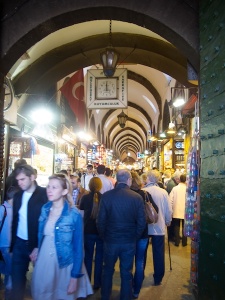 7. The bazaars. What a hoot. You should definitely not go into a bazaar if you need something or can’t roll with the punches. You will be accosted by every shopkeeper upon entry, who use centuries of experience in luring you into their store and getting you to buy something. If you actually want it, they will smell it on you. You might as well hand them your wallet
7. The bazaars. What a hoot. You should definitely not go into a bazaar if you need something or can’t roll with the punches. You will be accosted by every shopkeeper upon entry, who use centuries of experience in luring you into their store and getting you to buy something. If you actually want it, they will smell it on you. You might as well hand them your wallet
We did do some carpet shopping and got the usual treatment. First some hospitality is extended in the form of a drink and perhaps a little bite to eat. Then a presentation and a feeling out period where goods are shown to you, with no obligation to buy. As soon as you show some specific interest, the hunt is on, the hounds with their noses to the ground, following the scent. Good luck to the faint of heart.
So there you have it, a little glimpse into our three days in Istanbul. I hope to add a few narrated slide shows to give you a better feel for what we saw and what we did. Or just check back sometime next year. Because we will be going back for sure.
Ci vediamo!
(Yakında Görüşmek üzere!)
Bill and Suzy


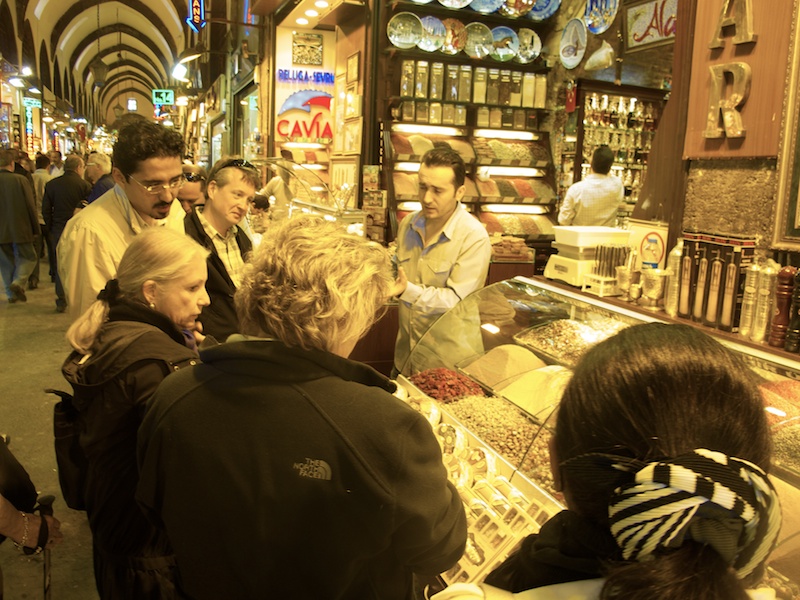
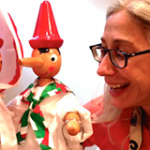
Comments
About The Author
Related Posts
Today Sandy created a little Pinnochio family! Which got us thinking, what kind of family…
I say "yum." A baked potato in parmigiano fonduta with truffle. At our restaurant for…